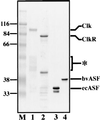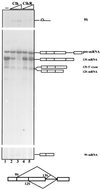The protein kinase Clk/Sty directly modulates SR protein activity: both hyper- and hypophosphorylation inhibit splicing
- PMID: 10490636
- PMCID: PMC84694
- DOI: 10.1128/MCB.19.10.6991
The protein kinase Clk/Sty directly modulates SR protein activity: both hyper- and hypophosphorylation inhibit splicing
Abstract
The splicing of mammalian mRNA precursors requires both protein phosphorylation and dephosphorylation, likely involving modification of members of the SR protein family of splicing factors. Several kinases have been identified that can phosphorylate SR proteins in vitro, and transfection assays have provided evidence that at least one of these, Clk/Sty, can modulate splicing in vivo. But evidence that a specific kinase can directly affect the splicing activity of SR proteins has been lacking. Here, by using purified recombinant Clk/Sty, a catalytically inactive mutant, and individual SR proteins, we show that Clk/Sty directly affects the activity of SR proteins, but not other essential splicing factors, in reconstituted splicing assays. We also provide evidence that both hyper- and hypophosphorylation inhibit SR protein splicing activity, repressing constitutive splicing and switching alternative splice site selection. These findings indicate that Clk/Sty directly and specifically influences the activity of SR protein splicing factors and, importantly, show that both under- and overphosphorylation of SR proteins can modulate splicing.
Figures







Similar articles
-
Akt2 regulation of Cdc2-like kinases (Clk/Sty), serine/arginine-rich (SR) protein phosphorylation, and insulin-induced alternative splicing of PKCbetaII messenger ribonucleic acid.Endocrinology. 2009 May;150(5):2087-97. doi: 10.1210/en.2008-0818. Epub 2008 Dec 30. Endocrinology. 2009. PMID: 19116344 Free PMC article.
-
The Clk/Sty protein kinase phosphorylates SR splicing factors and regulates their intranuclear distribution.EMBO J. 1996 Jan 15;15(2):265-75. EMBO J. 1996. PMID: 8617202 Free PMC article.
-
SRPK1 and Clk/Sty protein kinases show distinct substrate specificities for serine/arginine-rich splicing factors.J Biol Chem. 1996 Oct 4;271(40):24569-75. doi: 10.1074/jbc.271.40.24569. J Biol Chem. 1996. PMID: 8798720
-
A critical update on the strategies towards small molecule inhibitors targeting Serine/arginine-rich (SR) proteins and Serine/arginine-rich proteins related kinases in alternative splicing.Bioorg Med Chem. 2022 Sep 15;70:116921. doi: 10.1016/j.bmc.2022.116921. Epub 2022 Jul 9. Bioorg Med Chem. 2022. PMID: 35863237 Review.
-
SR protein kinases: the splice of life.Biochem Cell Biol. 1999;77(4):293-8. Biochem Cell Biol. 1999. PMID: 10546892 Review.
Cited by
-
Optimization of a weak 3' splice site counteracts the function of a bovine papillomavirus type 1 exonic splicing suppressor in vitro and in vivo.J Virol. 2000 Jul;74(13):5902-10. doi: 10.1128/jvi.74.13.5902-5910.2000. J Virol. 2000. PMID: 10846071 Free PMC article.
-
The regulation and function of post-transcriptional RNA splicing.Nat Rev Genet. 2025 Jun;26(6):378-394. doi: 10.1038/s41576-025-00836-z. Epub 2025 Apr 11. Nat Rev Genet. 2025. PMID: 40217094 Review.
-
Allosteric interactions direct binding and phosphorylation of ASF/SF2 by SRPK1.Biochemistry. 2009 Dec 8;48(48):11432-40. doi: 10.1021/bi901107q. Biochemistry. 2009. PMID: 19886675 Free PMC article.
-
SR proteins SRp20 and 9G8 contribute to efficient export of herpes simplex virus 1 mRNAs.Virology. 2010 Jun 5;401(2):155-64. doi: 10.1016/j.virol.2010.02.023. Epub 2010 Mar 12. Virology. 2010. PMID: 20227104 Free PMC article.
-
HiFENS: high-throughput FISH detection of endogenous pre-mRNA splicing isoforms.Nucleic Acids Res. 2022 Dec 9;50(22):e130. doi: 10.1093/nar/gkac869. Nucleic Acids Res. 2022. PMID: 36243969 Free PMC article.
References
-
- Cáceres J F, Stamm S, Helfman D M, Krainer A R. Regulation of alternative splicing in vivo by overexpression of antagonistic splicing factors. Science. 1994;265:1706–1709. - PubMed
-
- Cardinali B, Cohen P, Lamond A I. Protein phosphatase PP1 can modulate 5′-splice site selection in a HeLa splicing extract. FEBS Lett. 1994;352:276–280. - PubMed
Publication types
MeSH terms
Substances
Grants and funding
LinkOut - more resources
Full Text Sources
Other Literature Sources
Research Materials
